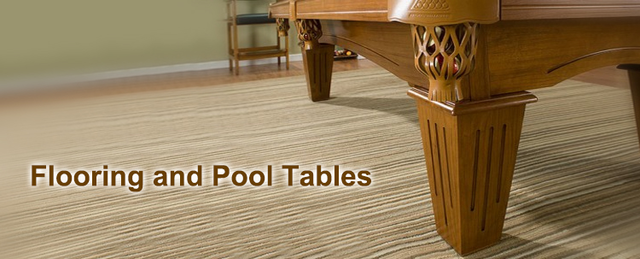Is your game room carpeted? While carpet softens and warms a room, especially in colder climates or finished basements, carpeting presents challenges for your pool table. A stable, level floor is essential to proper positioning of your table. While carpet is not the best option, with understanding you can have carpet and your pool table at the same time.
Carpeting Challenges
Most carpet rests on a cushion of foam padding. This padding provides the cushy feeling of carpet on your feet and protects the carpet from moisture or damage from the subfloor itself. Finished basements, especially, require thick padding under carpet to soften the typically concrete subfloor under foot and prevent moisture from damaging carpet fibers. Padding is great for carpet, but not so good for pool tables.
Padding Is made of foam and is crushed by the weight of your pool table. It takes a few weeks for the padding to crush down to its final thickness under your table, making leveling a challenge. When you place a pool table on carpet you should expect to adjust the level as the carpet changes shape and settles.
Unfortunately, the crushed padding will not assume its original shape when the pool table is removed. Not an issue if you plan to live in your home indefinitely and have no plans to remove the pool table. If, however, you repurpose your game room or wish to move your table the carpet will show noticeable dents where the pool table was positioned. If you try to sell your home you will need to either replace the carpet or explain the dents to potential buyers.
Replacing carpet beneath your pool table is complicated. Carpet is stretched during installation to remove wrinkles and bumps. There is no way to stretch the carpet under a sitting pool table. Instead, your installers will lift the table one end at a time and roll the carpet beneath it. They will then stretch the carpet in all four directions away from your table. Not the best possible solution.
Positioning Your Pool Table on Carpet
Installing a pool table on carpet is tricky business. Moving the table into the room can damage the delicate fibers of your carpet, leaving tracks from the door to the table’s ultimate home. To avoid this lay a tarp or heavy cloth over the carpet and slide the table dolly across along it. When the table is in position, remove the tarp.
Leveling on Carpet
Although you will have to make adjustments, a good step towards getting your table's level correct is waiting two or three days after the weight of the slate has been on your carpet before beginning the leveling process. Level the table in its current position using wooden shims. This is a trial and error process sometimes involving multiple adjustments until the table is level. You can gauge the level of the table by using a marble placed at the center of the playing surface. It should not move or roll in any way on a level table.
As the carpet settles, your table will lose its level status. You will begin to notice changes in the quality of play. The marble test will show you the amount of change in your table’s position. At this point you will need to adjust the shims and level the table again.






